Affiliate links on Android Authority may earn us a commission. Learn more.
How it works: Google Glass
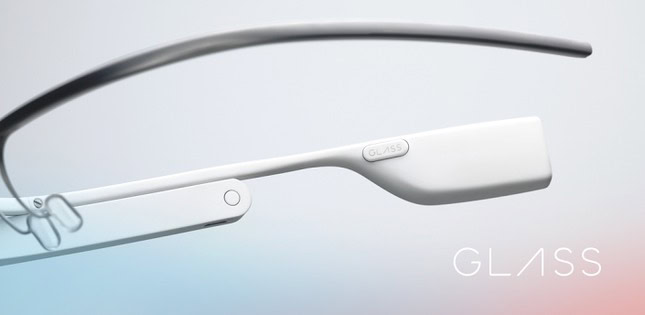
After much anticipation, Google Glass has finally shipped out to eager Explorers, who have begun posting their thoughts and experiences on the web. What this also means is that we finally have a full understanding about the exact features included with Google Glass, and how the little device works.
So here’s a breakdown of everything we know about Google Glass, and how exactly it all works.
Specs
Firstly, here’s a quick reminder of the specs, and what Google Glass is capable of. The unspecified resolution display works using a small projector embedded in the headset, which Google claims is the equivalent of a 25-inch high definition screen seen from eight feet away. There’s a 5-megapixel camera for photographs, which is also capable of capturing video at 720p. There’s plenty of room to store these snaps, thanks to the built-in 16GB of memory (12GB is available to the user), which is synced with Google cloud storage as well.
There are no speakers or audio jack ports on Google Glass. Instead, audio is transferred to the wearer via a conduction transducer which sends vibrations through the bones in your head, which we’ll cover a little later.
Google Glass also comes with the usual Wi-Fi 802.11b/g connectivity and is Bluetooth 4.0 compatible.
My Glass App
Equally as important as the actual hardware is the My Glass app which accompanies the headset. This app is responsible for controlling the connection between your smartphone and Google Glass, as well as allowing to you receive calls, etc.
As Google Glass doesn’t have a mobile antenna or GPS tracking, My Glass is essential if you want to send and receive SMS from Google Glass, use a data connection, or navigate using GPS. Usually Glass will connect with your smartphone via Bluetooth, when out of Wi-Fi range, in order to share and sync this information. However, if your mobile data plans supports tethering, then you can also connect Glass to your smartphone using that method instead.
I suppose you could think of this as an advanced hands-free Bluetooth kit or something equivalent to a super smart smartwatch. Google Glass isn’t actually making calls or sending messages, instead these are transferred to and from your smartphone.
Hardware
Ok that’s the simple stuff, but how exactly does Google Glass accomplish its vision? To fully understand just what makes Google Glass tick we’ll need to delve a little deeper into exactly how it works, and how this affects the user experience.
Display: Projection
You might assume that a head mounted display would try to place a screen in front of the eye for users to look at. Google Glass even appears to house a tiny little display in front of the eye. However, there are a few problems with that sort of technology, mainly due to the fact that focusing on objects at very close range is virtually impossible. Instead Google Glass works by beaming an image directly onto the retina at the back of your eye.
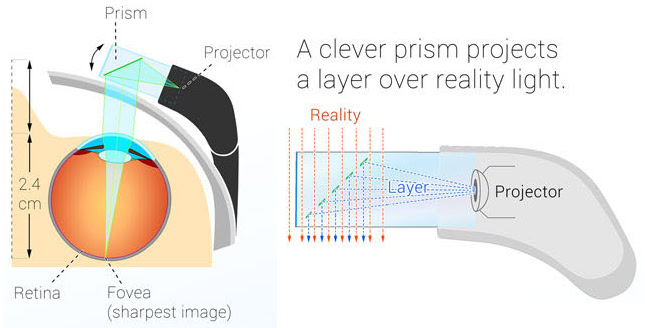
The clever virtual HUD overlay is actually based on quite a simple premise: there’s a mini-projector located inside Google Glass which projects an image onto a semi-transparent prism. As the prism is semi-transparent, the projector’s image is reflected into the user’s retina whilst still allowing for regular light to pass through the prism and into the eye.
As everyone’s faces and eyes are slightly different, Google Glass allows for the angle of the prism to be adjusted slightly in order to obtain optimal focus for the project image.
If you haven’t already seen this handy infographic then you should check it out, as that will hopefully make everything crystal clear.
Audio: Bone-conduction
Perhaps the most interesting piece of technology used in Google Glass, especially for an audio buff like myself, is the use of bone conduction in order to transmit audio to the wearer’s ear.
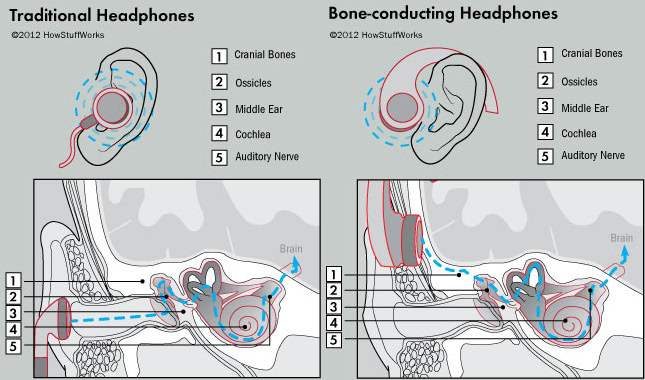
The remarkable thing is that we’re all used to hearing this sort of thing every time we talk. Vibrations in the throat travel through the more ridged material of our jaw and cheekbones, which are connected up to the inner workings of the ear.
The technology used in Google Glass works in much the same way, sending vibrations through your bones to the inner ear. Usually sound waves pass through the auditory canal and on to the eardrum, which vibrates when exposed to the energy from sound waves. On the other side of the eardrum there are three small bones, the ossicles, which transmit the vibration to the cochlea. The cochlea is tiny a fluid-filled structure which contains miniscule hair like stereovilli, which are stimulated by vibrations and convert the energy to electrical impulses that are sent along the auditory nerve to the brain.
When the bones vibrate the sound reaches the cochlea just as it would when sound waves pass through the middle ear and vibrate the eardrum. So even though the method of transmission is different, the sound is detected by the nerves and transmitted to the brain in exactly the same way.
Touchpad
Navigation was always going to be a key issue for Google Glass. Without keys or a touch screen, finding your way to many of the behind the scenes options and settings would be a pain. Fortunately Google Glass includes a touchpad on the right hand side, just behind the camera, which adds this important functionality.
The touchpad is used for accessing more advanced menu options and context sensitive options like sharing, deleting, etc. Tapping the touchpad will grant users access to menus, and swiping backwards or forwards along the touchpad is used to navigate. To cancel or back out of certain actions users need slide their finger from the top to the bottom of the touchpad.
The touchpad is also used for voice calls, user’s swipe up and tap to accept incoming calls and swipe down to reject, same thing for hanging up.
Capture button
On top of navigating your way through various menus, voice commands aren’t always necessarily the fastest or most appropriate method of performing a certain task. Take photographs or video for example, clicking a button is simpler and faster than speaking a command. But the Google engineers foresaw this problem, and have included a button specifically for taking pictures and recording video.
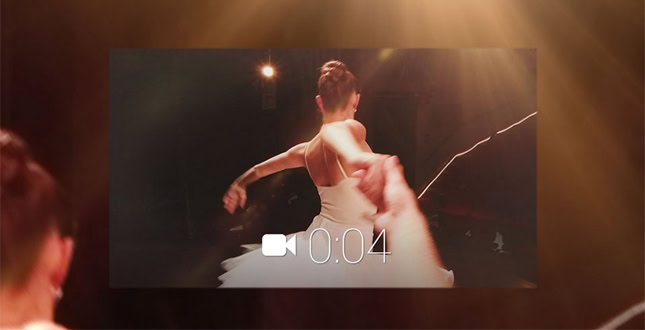
There’s a little capture button on the right side of the headset, which can be pressed once to take a quick snapshot, or held down for one second to start recording a 10 second video.
But that’s enough about hardware functionality; turn to the next page to see how Google Glass’ software goes about performing everyday tasks.
Software
By now we all know how Google Glass works, at least as far as putting it on your head and transmitting information from device to user. But the real functionality lies in the software.
Voice commands
I’m sure you’ve all seen the videos showing off the ease in which users can direct Google Glass to perform certain actions. This is the core of the Google Glass experience, voice commands will be the main way to get things done. All of the most common actions you’re likely to undertake using Google Glass can all be accomplished through the use of voice commands. All the tasks start with the phrase “ok glass”, followed by whatever you’d like Google Glass to do.
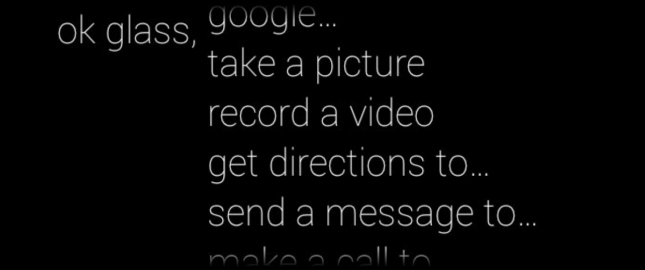
Pictures and video can already be captured with the dedicated button, but if you’re feeling too lazy to reach up to eye level you can always just issue a voice. “Ok glass, take a picture” will take a quick snapshot and display a preview of it, whilst “ok glass, record a video” will start a 10 second video capture. Longer videos can be recorded by tapping the touchpad and selecting “extend” from the menu.
By now I’m sure you get the idea, but there are quite a few more commands to go through. “Ok glass, get directions to” will open up the navigation tool, providing you’ve synced up Google Glass using the My Glass app. You can navigate to specific places, or use the local search type feature to find nearby businesses. The touchpad is used to scroll through the available results and to switch between walking or biking directions.
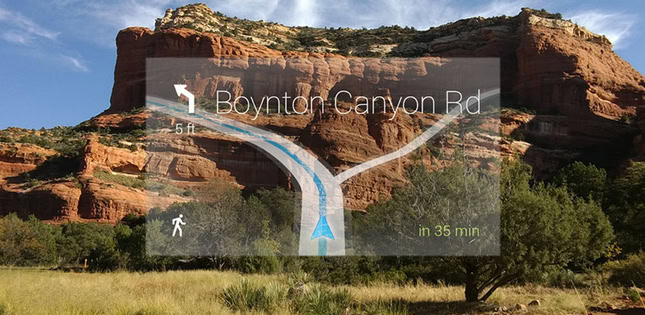
“Ok glass, send a message to” and “make a call to” are pretty self explanatory. Providing you’ve set everything up with the My Glass app and are connected to your smartphone via Bluetooth you’ll have full access to SMS and mobile calls.
For Google+ users there’s also the handy “ok glass, hang out with” feature, which will start a Google+ Hangout with your specified friend. And finally there’s “ok Glass, Google”. Those familiar with Google Now will probably already have a feel for how the search functions works, where simple questions can be posed to the device and certain answers will receive a spoken or card response, whilst others will return a web result.
Android/Google Now
Those of you with smartphones or tablets running Jelly Bean are no doubt familiar with the ever so convenient Google Now, which is also the basis for Google Glass’s information on demand feature. Rather than having to ask for specific pieces of information, Google Glass can and will occasionally display small cards of relevant information depending on when it thinks you’ll need it.

At this time, Google Now Glassware includes calendar appointments, flight information (if you have Gmail and web history enabled), places, sports results, stocks prices, and weather forecasts and updates.
Google Now works on Google Glass due to the fact that it’s running Android. Although we don’t know exactly which version, I suppose it’s going to be Jelly Bean at least. This also means that developers should have an easier time creating and adapting existing apps for use with Google Glass.
Timeline Cards
All of the actions done and received by Google Glass are placed in a timeline, which works as the main interface when interacting with Glass. Similar to the changes made to Facebook a while back, any pictures you take, calls you miss, and notifications you receive will all be recorded in chronological order for you to review if need be. Swiping the touchpad from the homepage will allow you to move forward and backward in time through your history.
This way you can go back and share pictures you’ve taken previously, and find previous notifications, translations, or cards based on the order in which they were received. Here’s a video showing some of the functions which can be performed using cards:
http://www.youtube.com/watch?v=q6HwZtnVKAQOthers
There’s also a bunch of other clever software features which help make Google Glass more practical. There’s the “head wake” setting which will wake up the display by tilting your head rather than having to press the touchpad. You can even specify how far you can tilt before the headset wakes up. “On head detection” will activate Glass when it senses you’ve put it on, there’s features for allowing guests to use the device, and probably tons of other stuff hidden away.
Phew, I think that’s finally everything. If you stuck through that information overload, hopefully you now have a full insight into Google Glass and now know what to expect if you ever find yourself owning a pair. Now we just have to wait another year before we can test all this out for ourselves.